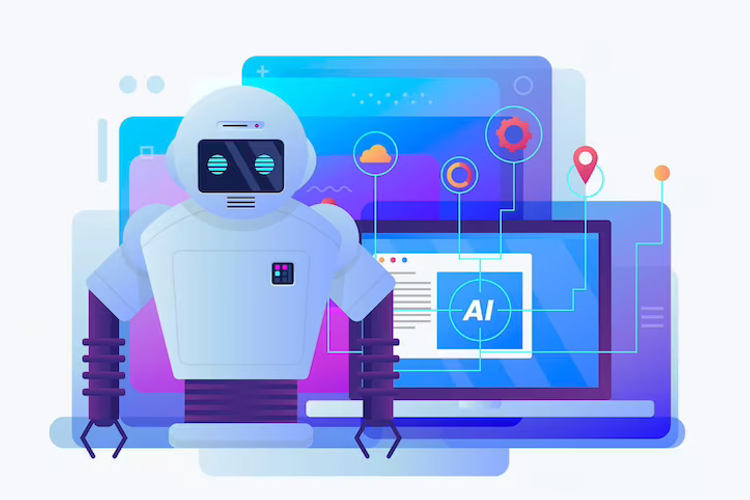AI (Artificial intelligence) has the potential to become the DNA of web design in the future due to its ability to improve and revolutionize the design process. AI (Artificial intelligence) has the potential to become the DNA of web design in the future due to its ability to improve and revolutionize the design process.
So the web design companies that are following the latest trends of technology are among the highest paid companies. And phoenix web design company is the award winning company that applies the latest AI’s principles to its projects to beat the compatibility of modern world. And such companies are making much more revenue than other IT companies that use AI in their daily projects. As a result, the AI industry is predicted to reach a remarkable $15.7 trillion by 2030.
Web accessibility is a problematic issue. It must handle issues of accessibility for those with auditory, cognitive, physical, visual, and a variety of other impairments. However, accessible website design is crucial to provide individuals with disabilities access to the internet.
Significant progress has also been made in how AI may be utilized to improve online accessibility. As a result, these technologies are causing actual change and assisting firms in optimizing their operations. In this article, we will discuss how AI can help designers to improve web accessibility.
What is Web Accessibility?
Web accessibility is creating inclusive web applications and making them equally accessible to all users, regardless of their skills or limitations. The ability to perceive, comprehend, navigate, participate, and contribute to web applications is a critical component of web accessibility.
It is also a technique for including various user categories from various situations, locations, and abilities. The objective is to guarantee that these users may benefit from any application without any impediments.
What is AI?
AI (artificial intelligence) is a discipline of study concerned with intelligent computers and programs capable of emulating human intellectual characteristics. It can perceive, learn, predict, and analyze.
Every day, AI and its branches significantly contribute to practically every sector. For example, this technology has influenced telecommunications, banking and finance, transportation, healthcare, logistics and entertainment.
How AI is influencing Web Designers
Here are a few ways AI is influencing web designers to improve web accessibility and how it will continue:
-
Efficient design
AI can help designers create website layouts and designs more effectively by automating processes like choosing picture scaling and color schemes. This allows designers to focus on more creative and strategic work while allowing for shorter turnaround times.
-
Improved user experience
By analyzing user behavior and identifying design pain points, AI can help designers create more intuitive and user-friendly websites.
-
Personalization
By analyzing user data and changing the design accordingly, AI may help web designers develop more personalized user experiences. This enables websites to adapt to individual users’ distinct interests and demands, resulting in a more engaging and practical user experience.
Furthermore, this enables designers to better fulfill the requirements and expectations of consumers by optimizing the navigation, layout, and overall user experience of a website.
-
Enhanced accessibility
AI can help make websites more accessible for persons with impairments by automatically producing alt text for pictures or giving text-to-speech features. This contributes to ensuring that websites are inclusive and accessible to a broader audience.
Why Does Every Website Need Accessible Design?
Some clients may wonder why their websites must be designed to accommodate persons with impairments. Here are a few reasons why building a website with accessibility in mind is worthwhile.
-
Increasing Customer Base
A user-friendly website will attract customers that an inaccessible website would naturally drive away. If the customer cannot browse the site, no amount of well-designed information, great images, or intelligent features will be successful.
-
Ease of Use
Many accessibility technologies make it easier for non-disabled consumers to shop, and innovative, accessible designs will be nearly undetectable to those who do not require them.
-
Accessibility Litigation
A website that fails to meet many accessibility regulations is not only a liability but also a missed opportunity.
How AI Affects Web Accessibility
With the rising incorporation of AI in digital goods, the requirement for using it to help web accessibility testing was seen early on. The capacity of a well-trained program to recognize data and provide several solutions to any given problem was seen as AI’s most significant promise.
When the same program is given with user accessibility criteria and is correctly educated for inclusivity, it can fulfill the more sophisticated accessibility demands of end users. In addition, AI can address various other issues that disabled users experience.
Aside from that, analyzing a massive number of web accessibility needs and identifying feasible solutions using human ability takes time. However, AI’s powerful algorithms can handle this with incredible speed and accuracy.
AI and web accessibility serve as a support system by removing barriers, simplifying user activities, and providing an alternative method for accomplishing challenging tasks. For example, facial recognition is an AI-powered alternative to inputting passwords intended to help visually impaired users or those with wounded limbs.
How AI Can Improve Web Accessibility
Accessing websites with password-protected logins is one area where AI can assist, particularly for persons with mobility and visual limitations. For example, if you prefer to use a mouse on the internet because you only have one free hand or are visually handicapped, inputting long passwords might be difficult or impossible. Facial recognition technology, which is now employed in smartphones and occasionally in computers, eliminates the need to key in these passwords and allows persons with motor and visual limitations to log into any website they need to without the security dangers that come with a short password.
Because typing in CAPTCHA codes or selecting images containing cars from a crowd can be an unreasonable request for someone with motor or incredible visual disabilities, facial recognition technology is being used as an alternative to CAPTCHA, the way websites ensure their users are not robots.
AI can do a lot to make the internet more accessible for persons with movement limitations, but its potential is much higher for those with vision or aural difficulties. AI technology can immediately and automatically construct subtitles for movies in different languages, and the accuracy of these captions is constantly increasing.
AI can study, recognize, and explain pictures for users who use a screen reader to browse a website. Technology is still in development, but it is continually developing and expanding the capacity of websites to give complete information to everyone, no matter what.
Conclusion
As AI technology advances, it is expected to become a more fundamental element of web design. Web designers will be able to develop more personalized, efficient, user-friendly, and accessible websites for their clients using AI. They can make more accurate and user-friendly websites by using the latest AI technologies.
To summarize, a well-designed website is critical for any business seeking to flourish online. We can construct a website that successfully conveys your brand, attracts quality traffic, and drives action with the expertise of professional web designers and the power of artificial intelligence.




